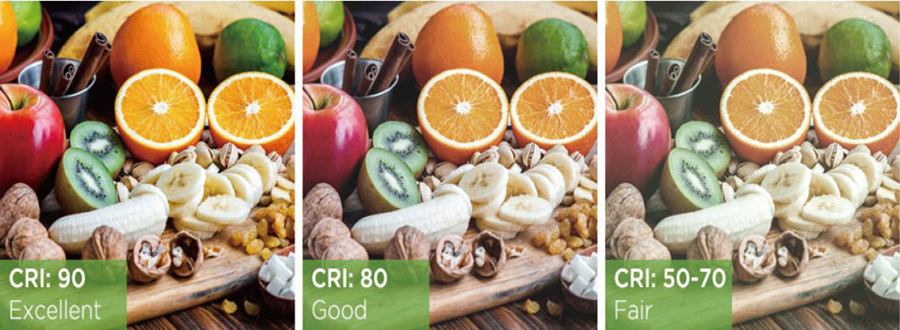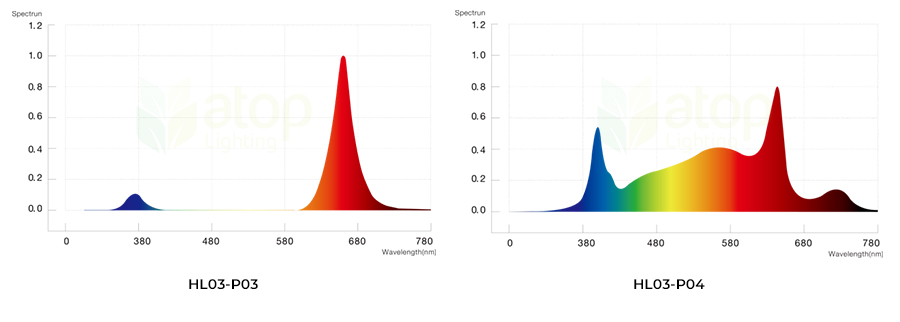What Is CRI and Is It Important for Plant Growth
CRI, the abbreviation of Color Rendering Index, is a critical factor evaluating the light quality. When we select lighting fixtures to increase our visibility and brighten the environment, CRI is one of the common parameters in specification sheets. However, it seems that CRI is not an important factor always valid for all lighting fixtures. Some grow light manufacturers indicate CRI values while others do not. This chaotic phenomenon makes most growers confusing. They don’t know whether CRI is important for plant growth. If CRI is vital for plant growth, what is the optimal value? If not, why CRI does not have significant impact on plant growth? Since some growers may not have a clear concept of CRI, this post will introduce CRI first. And then, we will talk about whether CRI plays an important role on plant growth.

What is CRI
CRI (Color Rendering Index) refers to the ability of a light source revealing the actual colors of objects. CRI ratings scales from 0 to 100. The higher the CRI rantings, the greater the color-rendering ability. Low CRI light sources will make the objects look unnatural and dull. Natural sunlight has the highest CRI value, 100. It can show the true color of objects. Therefore, CRI is used to evaluate the ability of a light source to show the real and natural color in comparison with sunlight. In other words, objects placed under a high CRI light source will appear the same color as they do under natural light. What should we keep in mind is that CRI is a metric used for human applications. It is not difficult to understand as the colors of objects are perceived and elevated based on human visibility.
Of course different light sources have different CRI. Incandescent lights are of higher CRI above 95, while the CRI of fluorescent lights range from 50 to 98, depending on specific light specification. For example, fluorescent lights (cool white) have a CRI of 60. The CRI range of LED lights is about 80 to 90. HPS lights have CRI values between 20 and 40. Generally, CRI values under 50 are regarded as uncomfortable light quality to human eyes. People are difficult to work under such light quality for a long period. CRI above 70 are recommended for human lighting.
Is CRI important for plant growth
CRI is not important for plant growth. Simply because plants perceive and use light differently than humans. CRI is a metric formed for human applications, not the horticulture. Light spectrum, intensity, and duration are the important factors of grow lights to how plants respond and photosynthesize, not CRI values. A grow light have low CRI does not mean it is not beneficial for plants growth.
-
CRI is used for human applications
CRI means the ability of a light source to show the actual colors of objects in comparison with sunlight. A grow light with high CRI just means it has better capability to reveal the colors of plants under natural light. But the colors of objects are perceived by human eyes. Humans have better perception on green and yellow light than blue and red light, which is different from plants. Moreover, the CRI values are elevated based on human perception. Thus, CRI is not important for plant growth. But it affects the human visibility. Many growers, especially those growing plants in indoor farms, complain the unclear visibility due to the grow lights of low CRI. It is hard for them to distinguish the true color and the condition of plants.
-
Not CRI, but the useful spectrum is important for plant growth
As mentioned before, CRI values of HPS light are as low as 20. However, HPS lights have been used for grow lights for a long time. Grow lights of low CRI dot not mean they are bad lights. The reason of growers use LED grow lights instead of HPS lights is the high energy consumption and heat of HPS light, not their low CRI. Actually, there are two factors associated with CRI values of grow lights: the continuity of light spectrum and the relative intensities of different light wavelengths. A grow light with high CRI has a smoother and more continuous spectral power distribution. HPS lights have discontinuous spectral power distributions, and this results the low CRI. Although the spectral distribution of some grow lights are discontinuous and uneven, particular part of light spectrum may be beneficial for plants. Therefore, grow lights will low CRI may be beneficial for plant growth.
Here is a picture of the light spectrum of HL03 Horti-Reina, an LED interlighting that is typically designed for vine crops and medical cannabis. Horti-Reina is available in two spectrum, HL03-P03 and HL03-P04. HL03-P03 is the bimodal spectrum with 450nm blue light and 660nm red light, which offer the high photon yield efficacy of the available spectra. This spectrum is efficient in increasing plant anthocyanin, chlorophyll, and carotenoid. HL03-P04 enhanced full spectrum produces the fastest flowering for plant species grown under artificial lighting. The spectrum most closely mimics the sun and can meet the needs of both high and low DLI crops. The bioptical gain of far-red light on photosynthetic rate is beneficial to promote plant growth and increase plant yield.

It is quite clear that HL03-P04 are of more contentious spectral distribution. And HL03-P04 has a higher CRI value than HL03-P03.
Does HL03-P03 negative to plant growth due to the low CRI?
Absolutely not!
Since HL03-P03 is helpful for plant growth , it is hard to draw a conclusion that low CRI is negative to plant growth.
In conclusion, CRI is not important for plant growth. It is meaningless to spend efforts on considering the CRI value of a grow light. Concentrating on light management, light spectrum, intensity, and duration are the main factors that affect the photosynthesis and plant growth. Featuring the right and precise light intensity and duration for plants may be difficult for novice growers. Thus, selecting the appropriate light spectrum for plants is the cornerstone of successful horticulture. Atop focus on the light that is most effective and beneficial for better plant growth, higher production, and more yields. Contact us to get your own lighting solution.

